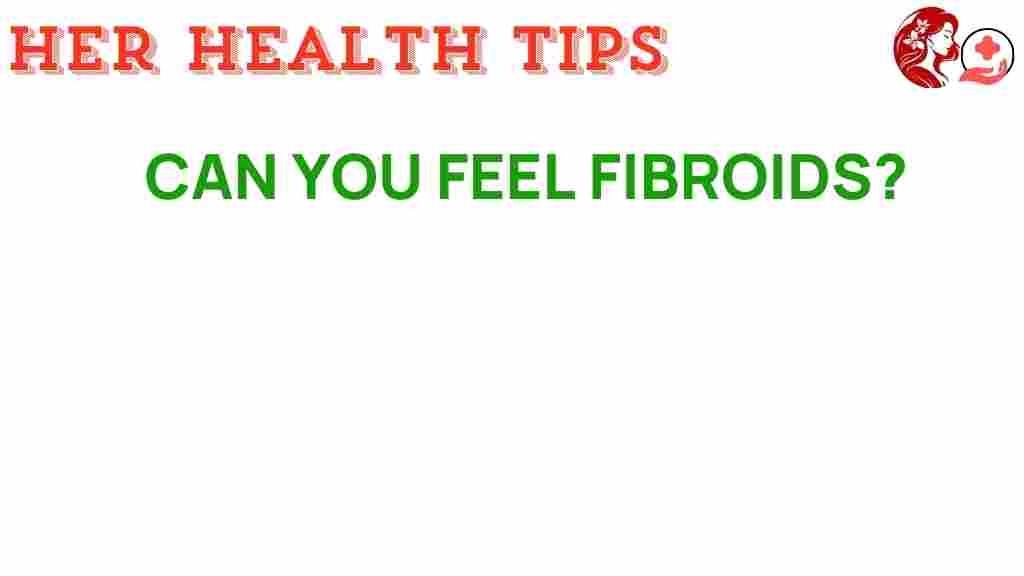Unveiling the Hidden Symptoms: Can You Feel Fibroids?
Fibroids are non-cancerous growths that develop in or on the uterus. They can be small or large, and while many women may be unaware they have them, others experience a variety of symptoms that can significantly impact their quality of life. Understanding the symptoms of fibroids is crucial for women’s health, as awareness can lead to timely diagnosis and appropriate healthcare interventions. In this article, we will explore the hidden symptoms of fibroids, how they can affect reproductive health, and the importance of education on this common condition.
What Are Fibroids?
Fibroids, also known as uterine leiomyomas or myomas, are muscular tumors that grow within the wall of the uterus. They can vary in size, number, and location, leading to different symptoms and complications. Fibroids are quite common; studies suggest that up to 80% of women will develop fibroids by age 50. However, many women may not experience any symptoms and may remain unaware of their presence.
Understanding the Symptoms of Fibroids
Many women with fibroids do not experience noticeable symptoms, but those who do may face a range of issues. Here are some common symptoms associated with fibroids:
- Pelvic Pain: This is one of the most common symptoms. Women may experience a feeling of heaviness or pressure in the pelvic region.
- Heavy Menstrual Bleeding: Fibroids can cause prolonged and heavy menstrual periods, leading to anemia and fatigue.
- Frequent Urination: Large fibroids can press against the bladder, causing increased urgency and frequency of urination.
- Constipation: Fibroids can exert pressure on the intestines, leading to constipation and discomfort.
- Back Pain: Some women report lower back pain associated with fibroids, especially if they are large or located in certain areas.
- Abdominal Swelling: Fibroids can cause distension or bloating in the abdomen, giving the appearance of weight gain.
- Pain During Intercourse: Depending on their size and location, fibroids can cause discomfort during sexual activity.
It is important to note that while these symptoms can indicate the presence of fibroids, they can also be associated with other medical conditions. Therefore, awareness and education regarding women’s health are essential for seeking appropriate diagnosis and treatment.
The Importance of Awareness and Education
Awareness about fibroids is vital for early diagnosis and effective management. Many women may dismiss their symptoms or attribute them to normal menstrual discomfort, delaying their visit to a healthcare provider. Education surrounding fibroids should include:
- Understanding the risk factors, such as family history, age, and hormone levels.
- Recognizing the potential symptoms and their impact on daily life.
- Knowing when to seek medical advice or intervention.
Healthcare providers play a crucial role in educating women about fibroids. Regular check-ups and open conversations about menstrual health can help identify symptoms early. For more information on women’s health and fibroids, check out this resource on fibroids and their impact.
Diagnosis of Fibroids
If you suspect you have fibroids based on your symptoms, it’s essential to seek a diagnosis from a healthcare professional. The diagnostic process may involve:
- Medical History Review: The healthcare provider will discuss your symptoms and medical history.
- Physical Examination: A pelvic exam may help detect any unusual growths or tenderness.
- Imaging Tests: Ultrasound, MRI, or CT scans can provide detailed images of the uterus and confirm the presence of fibroids.
Early diagnosis can lead to better management strategies and improve overall reproductive health.
Step-by-Step Guide to Managing Fibroids
Managing fibroids involves a combination of lifestyle changes, medical treatments, and possibly surgical options. Here’s a step-by-step guide to help you navigate through this process:
Step 1: Monitor Symptoms
Keep track of your symptoms, their frequency, and their severity. This information will be valuable when discussing your condition with your healthcare provider.
Step 2: Consult with a Healthcare Provider
Schedule an appointment with a healthcare professional to discuss your symptoms. Be prepared to answer questions about your menstrual cycle, pain levels, and any other related issues.
Step 3: Explore Treatment Options
Based on your diagnosis, your healthcare provider may recommend several treatment options, including:
- Medication: Hormonal therapies can help manage symptoms by regulating your menstrual cycle and reducing bleeding.
- Minimally Invasive Procedures: Options such as uterine artery embolization can reduce the size of fibroids.
- Surgery: In severe cases, a hysterectomy or myomectomy may be necessary.
Step 4: Lifestyle Changes
Adopting a healthy lifestyle can help manage symptoms. Consider:
- Regular exercise to promote overall health.
- A balanced diet rich in fruits, vegetables, and whole grains.
- Stress management techniques such as yoga or meditation.
Troubleshooting Tips for Managing Symptoms
If you are experiencing symptoms of fibroids, here are some troubleshooting tips to help alleviate discomfort:
- Heat Therapy: Applying a heating pad to your abdomen can help reduce pelvic pain.
- Over-the-Counter Pain Relief: Nonsteroidal anti-inflammatory drugs (NSAIDs) may help manage pain and cramping.
- Hydration: Staying hydrated can help reduce bloating and discomfort.
- Track Your Cycle: Keeping a menstrual diary can help you identify patterns in your symptoms.
Always consult your healthcare provider before starting any new treatment or remedy.
Conclusion
In summary, fibroids are a common condition that can present a range of symptoms, from pelvic pain to heavy menstrual bleeding. Awareness and education are key components in identifying these symptoms early, leading to timely diagnosis and effective management strategies. By understanding your body and seeking appropriate healthcare, you can take control of your reproductive health and improve your quality of life. If you suspect you have fibroids, do not hesitate to reach out to a healthcare professional for guidance and support. Remember, you are not alone; many women experience similar challenges, and help is available.
For more information on women’s reproductive health, visit this external resource dedicated to educating women about fibroids and other health issues.
This article is in the category Reproductive and created by HerHealthTips Team
